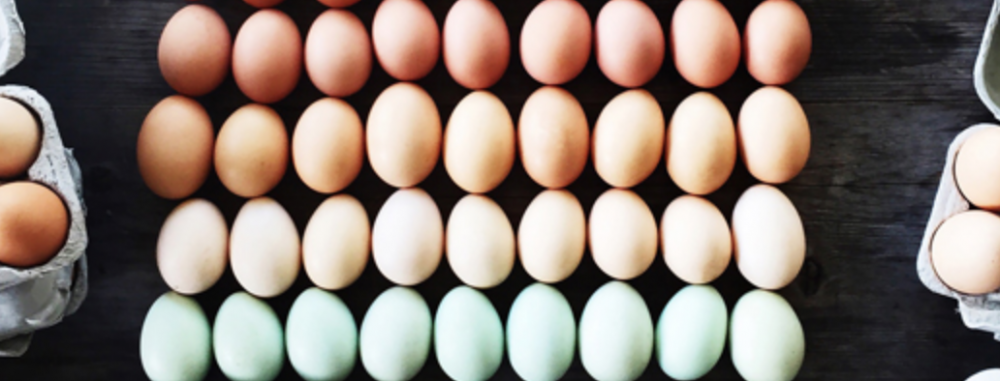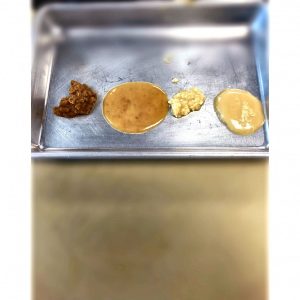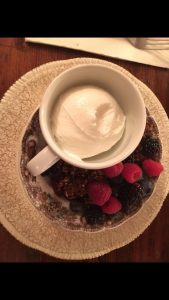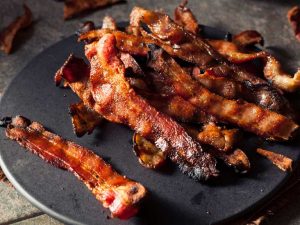I think the photo Falling Soldier by Robert Capa is real. From what I can see, the angle of the man’s legs are off-balanced. It will be hard for the man to maintain that position and wait for Capa to take the photo without the help of props. Furthermore, even if the falling is real, like what Captain Robert L. Frank said in Robert Whelan’s article, “It is nearly impossible for any conscious person to resist the reflex impulse to brace his fall by flexing his hand strongly backward at the wrist and extending his fingers out straight.” The feeling of being off balance and falling will jolt reflexes and impulses to help prevent or to minimize the pain upon impact. Another example of reflex is when people suddenly and out of nowhere hears an explosive sound, their heart are bound to beat faster and their muscles will tighten as the “fight or flight” instinct kicked in. Personally, I feel that the issue about whether Falling Soldier is staged or not varies according to the different lenses and criteria. If the goal of the photo is to show real events, then Capa’s photo’s authenticity matters. However, if it is to show the experience of war, then it does not matter whether Capa’s photo is staged or not, because the goal is to educate people about something.
Category Archives: #studentHW
HW #4 Robert Capa’s Death of a Loyalist Soldier
“Death of a Loyalist Soldier” by Robert Capa will always be seen as notable war photograph even if it was staged or not. After reading the article written by Richard Whalen I concluded with Whalen that Robert Capa’s photo was not a staged photograph. Robert Whelan made some great points on the validity of the photograph. During a time of war, I don’t think a photographer would have the time to even think about staging someone to take a photograph. I’m certain that bullets were flying everywhere, and soldiers were either securing a safe place for cover or either firing back at the other side. The authenticity of Capa’s photograph matters because what was captured in that photograph is what makes it valuable. Even if this wasn’t captured in a photograph, that was the time there was a war going on and that was how soldiers actually die without them expecting it or knowing when they will be shot. Another great conclusion was that of Captain Frank, who was shown the photograph and asked to give an opinion as if he it was an evidence in a homicide case. Frank after looking at the photograph, concluded that the person in the picture was actually shot. He noted that if you look at the person left hand, you will see that his fingers were curled, giving an indication the muscles have gone limp and he was already dead. He also stated that someone faking wouldn’t know that such a hand position was necessary.
Homework #3
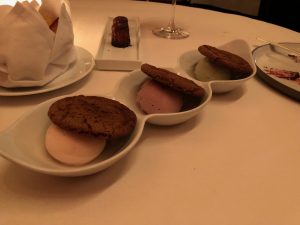
Dessert served sent by the chef -Maritza B Flores Here we can see three sorbets of different colors. This photo shows the plating chosen by the Chef at Cafe Boulud. This reminds me of the traffic lights in the streets. On top of these sorbets you can see brown cookies to end it with some decor. All these sorbets each have their own little place to rest on as they melt. The texture of these soft cookies can engage with these sorbets as they are slowly melting. Note how the cookies are leaning in on the sorbets and are both facing the same direction. This is how they were served.
HW#3: Photographing and Describing Composition: Oyakodon
The image is of an oyakodon which is a Japanese rice bowl dish consisting of egg, chicken, scallions and various other ingredients used as a garnish. In English oyakodon literally means parent child bowl and is supposed to be a representation of life. In this photograph the the egg is placed on top the rice serving as a canvas for the garnishes in a sense. On top of the egg, are the fish cakes which are sliced julienne and then sprinkled around the egg like grass. On top of that is a combination of the sliced scallion and sliced seaweed which represent life as plant life. Finally the slices of pickled radishes represent the sun which represents how the sun provides energy for everything on the Earth.
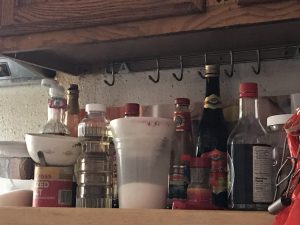
The things on kitchen counter. I’m from an Asian background, so other than the basic things like oil, sugar, salt, and MSG, there are bottles of different types of sauces. Some of the sauces are soy sauce, fish sauce, and oyster sauce. To make things convenient and efficient, these flavoring and seasonings are placed next to the stove.
Looking Deeper ! by Hyheda Barrett

In this picture composition it speaks alot as you can identify the professionalism and neatness of this baker or cake designer. The person illustrated in this photo her dedication to careful time,effort and incorporated design of the cake which depicts the end product. In the background captured by the photographer she looks as if she works for a bakery that specialize in maybe wedding cakes and their end product is really what matter the most .She also looks organized based on the tools in the background. Looking closer you can also see other types of cake made presumingly by the same person. Her pose with this cake tells alot such as professionalism, very detailed individual, neat, organized and passionated about cakes in general.
Lab #5 Sauces/ HMGT1203Sec.LC22
HW#2: Photographing and Describing Texture
This is a Greek yogurt served alongside granola and a combination of blueberries and raspberries. The texture of the yogurt is very thick and viscous similar to the texture of whipped cream. The granola provides a rough texture due to the dryness of the oats and is also rough due to the clumping of multiple pieces. The raspberries on the plate are firm on the outside and squishy the harder you pinch the berry. There are also little bits of furry bristles on the outside skin of the berry that feels like a gentle brush like feel to the berry. The blueberries are similar to the texture of the raspberries, but without the feel of the bristles on the outside. Instead there is just a smooth firm outer layer protecting squishy insides of the berry. Together the parfait creates a mixture of mouth feel textures mixing of textures where biting into granola helps create a crunch while everything else provides a smoother melt in your mouth type feel.
Homework 2: photographing and describing texture
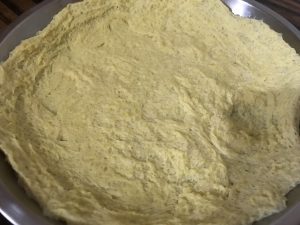
This is steamed egg. It is made by beating the egg and (sometimes) adding in water. As a result, this style of egg is similar to tofu in which it is very soft and fluffy. If you poke at it with a chopstick it goes through easily and it is easy to rip a piece of it out. There are many air holes, as you can see in the picture, the lumps and tiny black spots. The reason why it looks wrinkly is because as you steam it, the egg grows. When you take it out of the pot, it will quickly shrink as the hot air escapes. The edge of the egg is irregular is the same reason.
The Texture Of Bacon
There are few foods as sensual and appealing as bacon. The mere smell of it can take you by the nose and lead you across the house to the kitchen. It vaults anything from eggs to chocolate to Brussels sprouts to new levels of deliciousness.Bacon is from the pig belly, which is part of the loin. Fresh pig belly can be cooked in a variety of ways.When most people talk about bacon, they tend to talk more about its texture than its flavor. The usual adjectives used to describe bacon are crispy and chewy, salty and savory. Smoky is often mentioned, but rarely is bacon described as sweet.From the very first bite, texture and chewing play crucial roles in how much we enjoy food.The taste of bacon breaking down into their delicious combination of sweet, nutty, grassy and buttery flavors, but we also love the textural interplay known as mouthfeel.In short, it’s all about mouthfeel the natural synthesis that happens when we simultaneously taste, chew and experience a food’s texture. It’s that melt in your mouth ecstasy we experience when eating the perfect bite.
